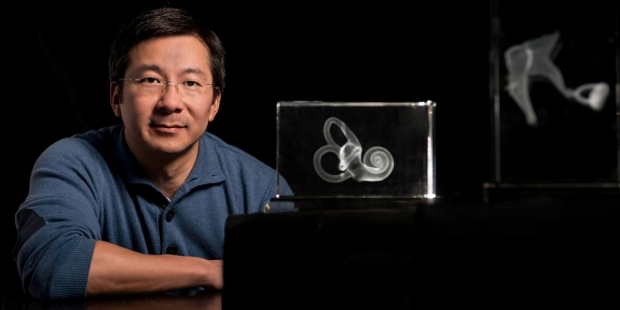Discovery in mice points to potential treatment for vestibular disorders
By Mandy Erickson
Researchers at the Stanford University School of Medicine have found a way to regenerate hair cells in the inner ears of mice, allowing the animals to recover vestibular function. It’s the first time such recovery has been observed in mature mammals.
If further research shows that the technique can be applied to humans, it would be an initial step toward treating vestibular disorders, such as dizziness. There is currently no effective treatment for dizziness and balance disorders caused by damaged or lost vestibular hair cells. The only available therapy is teaching patients coping mechanisms through physical therapy.
“This disabling condition is very common among the elderly, and one of the primary causes of falls,” said Alan Cheng, MD, associate professor of otolaryngology-head and neck surgery.
Cheng is the senior author of a paper about the research, which was published July 9 in Cell Reports. Zahra Sayyid, an MD-PhD student at Stanford, is the lead author.
The hair cells in the utricle, a section of the inner ear, help maintain balance and spatial orientation and regulate eye movement. Some antibiotics can damage these cells. Damage can also occur from infections or genetic disorders, or as a result of aging. In mature mammals, vestibular hair cells regenerate on their own only minimally. (Birds and fish, however, have the ability to completely regenerate them.)
This disabling condition is very common among the elderly, and one of the primary causes of falls.
In the United States, about 69 million people experience vestibular dysfunction, some because of problems with inner ear hair cells. They can feel as if they’re spinning, lose their balance easily, suffer from nausea and have trouble tracking objects with their eyes. The symptoms can prevent patients from engaging in activities, including exercise and driving, and can lead to social isolation.
To study these vestibular disorders, the researchers impaired the inner ear hair cells of mice and measured how well they regenerated on their own. The researchers found that about a third of the cells regenerated spontaneously but appeared immature, and vestibular function was inconsistent.
Next, they manipulated Atoh1, a transcription factor that regulates hair cell formation, in the mice. In the animals that overexpressed Atoh1, as much as 70% of hair cells regenerated. The regenerated cells appeared relatively mature, and about 70% of these mice recovered vestibular function.
“This is very exciting. It’s an important first step to find treatment for vestibular disorders,” Cheng said. “We couldn’t get sufficient regeneration to recover function before.”
The researchers plan to study how other methods to enhance Atoh1’s function may affect regeneration.
While the finding is a proof of concept, “it has opened the door for many more possibilities that could lead to treatment in people with vestibular disorders,” Sayyid said.
Other Stanford co-authors of the study are research scientist Tian Wang, MD, PhD, and medical student Leon Chen.
Researchers at the University of Nebraska also contributed to the study.
Cheng is a member of Stanford Bio-X, the Stanford Maternal & Child Research Institute, the Stanford Cancer Institute and the Wu Tsai Neurosciences Institute at Stanford.
The work was funded by the National Institutes of Health (grants F30DC015698, R21DC015879, K08DC011043, RO1DC013910, UL1TR001085 and RO1DC016919), the Stanford Medical Scholars Research Program, the Howard Hughes Medical Institute, the Stanford Medical Scientist Training Program, the Lucile Packard Foundation for Children’s Health, the Stanford Maternal & Child Health Research Institute, the Nebraska Tobacco Settlement Biomedical Research Development Fund, the Department of Defense, the Akiko Yamazaki and Jerry Yang Faculty Scholar Fund and the California Institute for Regenerative Medicine.
Stanford’s Department of Otolaryngology-Head and Neck Surgery also supported the work.
